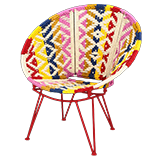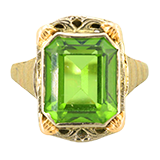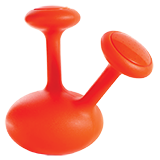The Original Collectors Series: Los Angeles, CA
After I graduated from the ArtCenter College of Design in Pasadena, I primarily did residential architecture, and then as the years progressed, I did a lot of built-ins, which turned into furniture. By the time the housing market collapsed, I was the design lead on multimillion-dollar residential projects, inside and out, top to bottom.
After the housing crash, I rented out my house in Hollywood Heights and moved into an apartment. I had all these boxes of vintage pieces that had been in storage. So I’m sitting there with no work, but surrounded by these incredible things I’d bought over the years, and I thought, maybe there’s a business there. That’s how my vintage business started.
I built up my personal collection over more than 10 years of going to auctions, flea markets, and thrift stores. In the early 2000s, people who were design-savvy were into Mid Century Modern, but the general population was not. So I’d go to flea markets and find pieces by Mies van der Rohe, Florence Knoll, George Nelson. And then I got obsessed with postmodernism, which is starting to get really hot now. I love the playfulness, which was a reaction to the “form follows function” mantra of modernism. In the sale, there’s a high 80s lamp, really classic American postmodern. There are also a couple of chairs by Ettore Sottsass, who founded the Memphis style, and another chair by Anna Anselmi for Bieffeplast.
When I went on shopping trips, I’d often be in this little Kia Soul. And people would always say, “You’re not going to fit anything in there.” And somehow I’d get in sofas, paintings—big pieces. There’s a rare blue marble cube I’ve been carting around for years, in and out of cars, up and down stairs.


St. Jacut Original Oil on Board

Luigi Onesto Oggetti Murano Art Glass Sculpture

Pair of Ettore Sottsass for Knoll Armchairs

Hand Blown Art Glass Bird Statue

John Bergen Vase

Signed Modernist Brass Sculptural Vase

Glass Top and Brass Side Table

Signed Ikebana Vase

Signed Lidded Art Pottery Jar

Handwoven Jaldar Wool Area Rug

Trio of Ceramic Vases

Signed Art Glass Vase

Pair of Teardrop Glass Vases

Pair of Artist Signed Ceramic Vases

Handblown Orange and Purple Glass Vase

Laslo for Mikasa Glass Vases

Signed Turquoise and Black Pottery Vase

Brno Tubular Chair

Signed Bill Kasper Glass Vase

David Zelman Candle Holder

John Bergen Vases and Serving Plate

Memphis Style Art Magazine Rack

Pair of Signed Postmodern Art Glass Vases

Italian Blue Marble Side Table

Pair of Pottery Pitchers

Duo of Prints by Rosado

Trio of Lidded Jars

Original Geisha Oil on Canvas Painting

Abstract Metal Sculpture by Ilana Ziff

Anna Anselmi for Bieffeplast Side Chair

Bagni for Raymor Lighter and Ashtray

Modern Wood and Glass Coffee Table

Signed Handmade Pottery Tray

Pair of Tapered Ceramic Vases

J.Frank Blue and Green Bowl

Pair of Vintage Brown Porcelain Vases

You were early to the Mid Century Modern and postmodern trends. What’s bubbling up now?
Ceramics, because they’re one of the few things where the designer’s hand comes through. In other media, like metalwork, glass or most painting, the artist’s hand doesn’t touch the work. With clay, you can see the mark of the person’s finger. It’s a highly individual. That’s the new movement—the opposite of mass production. There’s a pitcher in the sale where you can see the ridges of the person’s fingers. It’s very thin earthenware, which is very hard to achieve—it’s difficult to turn it that thin and not have it break when you’re firing it.
You also have a few Murano glass pieces.
That was another thing you used to be able to find in thrift stores, but it was almost impossible to identify. Then people started clueing into it, and it got really popular. Now it’s impossible to find. The only reason that Luigi Onesto green teardrop-shaped piece is in the sale is because I didn’t remember I still had it—otherwise it would have sold already.
How do you approach art collecting?
With a design education, it was easy for me to spot pieces. Even if I couldn’t identify the artist, I could spot quality. In my own personal living space, every inch was covered by artwork. I love female portraits, and two favorites are the Jacut and the Japanese woman in profile. I always did female portraits in my living room, and once a friend came over and said he was starting to get creeped out with all these woman staring at him!







